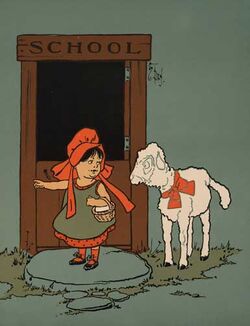| Mary | |
|---|---|
 | |
|
Real Name |
Mary Sawyer Tyler |
|
First Appearance |
March 22, 1806 |
|
Original Publisher |
Marsh, Capen & Lyon |
|
Created by |
Sarah Josepha Hale |
Origin
"Mary Had a Little Lamb" is an American nursery rhyme of nineteenth-century American origin.
The nursery rhyme was first published by the Boston publishing firm Marsh, Capen & Lyon, as an original poem by Sarah Josepha Hale on May 24, 1830, and was inspired by an actual incident.
As a girl, Mary Sawyer (later Mrs. Mary Tyler) kept a pet lamb, which she took to school one day at the suggestion of her brother. A commotion naturally ensued. Mary recalled: "Visiting school that morning was a young man by the name of John Roulstone, a nephew of the Reverend Lemuel Capen, who was then settled in Sterling. It was the custom then for students to prepare for college with ministers, and for this purpose Mr. Roulstone was studying with his uncle. The young man was very much pleased with the incident of the lamb; and the next day he rode across the fields on horseback to the little old schoolhouse and handed me a slip of paper which had written upon it the three original stanzas of the poem..."
There are two competing theories on the origin of this poem. One holds that Roulstone wrote the first four lines and that the final twelve lines, more moralistic and much less childlike than the first, were composed by Sarah Josepha Hale; the other is that Hale was responsible for the entire poem.
Mary Sawyer's house, located in Sterling, Massachusetts, was destroyed by arson on August 12, 2007. A statue representing Mary's Little Lamb stands in the town center. The Redstone School, which was built in 1798, was purchased by Henry Ford and relocated to a churchyard on the property of Longfellow's Wayside Inn in Sudbury, Massachusetts.
The rhyme is also famous for being the very first thing recorded by Thomas Edison on his newly invented phonograph in 1877. It was the first instance of recorded verse. The original recording is no longer in existence but in 1927 Edison re-enacted the recording which still survives.
In the 1830s, Lowell Mason set the nursery rhyme to a melody adding repetition in the verses:
- Mary had a little lamb,
- whose fleece was white as snow.
- And everywhere that Mary went,
- the lamb was sure to go.
- It followed her to school one day
- which was against the rule.
- It made the children laugh and play,
- to see a lamb at school.
- And so the teacher turned it out,
- but still it lingered near,
- And waited patiently about,
- till Mary did appear.
- "Why does the lamb love Mary so?"
- the eager children cry.
- "Why, Mary loves the lamb, you know."
- the teacher did reply.